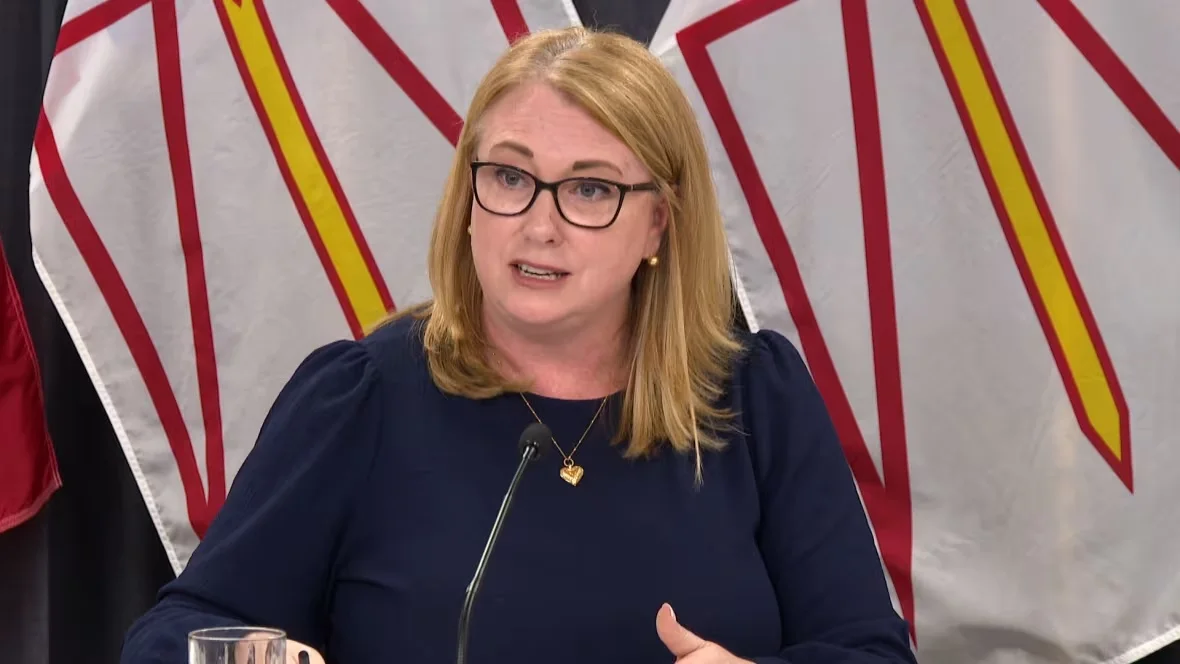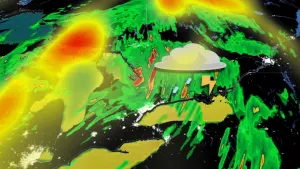
Fire jumps river, prompting full evacuation of power-generating Churchill Falls
A growing wildfire just a few kilometres away from the power-generating community of Churchill Falls has crossed the central Labrador river that was serving as a barrier from the town.
At a news conference Tuesday, Newfoundland and Labrador Premier Andrew Furey said the fire has jumped the Churchill River but still remains about seven kilometres from the town, as of around 3 p.m. NT.
CANADA'S WILDFIRES: Visit The Weather Network's wildfire hub to keep up with the latest on the active start to wildfire season across Canada.
"The fire has jumped the river, which is what we were trying to prevent. It's what we were all hoping wouldn't happen," Furey said in St. John's. The fire grew from a Category 2 fire to a Category 4 fire between Tuesday morning and Tuesday afternoon, he added.
"So there is very much a heightened level of risk of fire propagation now on the community side of the river," he said.
"We'll continue to provide mitigation efforts on both sides of the river, and we hope that that will contain the fire."
All personnel had been evacuated as of 6:15 p.m. NT.
Anyone evacuating Churchill Falls is asked to check in at the YMCA in Happy Valley-Goose Bay, according to Lake Melville MHA Perry Trimper in a Facebook post. Those travelling to Labrador West should check in at the local Royal Newfoundland Constabulary detachment.
Between 80 and 100 people remained in the community to operate the town's power plant, including operations and site services, fire services and clearing work for a fire break currently under construction.
The fire has closed the Trans-Labrador Highway from Labrador City and Wabush to Churchill Falls.
Newfoundland and Labrador Hydro told CBC News that workers deemed essential will be the last to leave the town, but officials aren't sure how long that will take.
Much of the town's population of around 750 people was evacuated last Wednesday.

Water bombers from Quebec were called into action to fight the fire burning near Churchill Falls. (Patrick Butler/Radio-Canada)
Jamie Chippett, deputy minister of the Department of Fisheries, Forestry, and Agriculture, said attention now shifts to fighting the leading edge of the fire — provided it doesn't get worse.
"If we can keep the fire from getting to Level 5 or a Level 6, then I think we would be working hard, similar to what we've been doing before," he said.
"If we get to a five or a six in classification, it's really at the limit or beyond the limit of bombers being able to be in the air."
'Planning for this eventuality'
Newfoundland and Labrador Hydro CEO Jennifer Williams said workers have been preparing for changes to the status quo.
"We were planning for this eventuality," she said. "That is why we made adjustments at the plant last night."
As a precautionary measure, Hydro had begun releasing water at its Churchill Falls power plant Monday night in case the Crown corporation needed to remove even more staff from an evacuated community already under serious fire threat.
"We will definitely continue to take direction from the officials, but in our planning scenarios we are planning for hotel rooms, we are planning for charter flights … arranged and on standby," Williams told reporters.

Newfoundland and Labrador Hydro began releasing water from the upper Churchill reservoir at the Jacopie Spillway on Monday. This image was taken in 2021, when water was released. (Peter Cowan/CBC)
Hydro had also already started reducing energy loads in anticipation of further evacuations. The release of water will also help beleaguered crews who face another hot, rainless day while trying to control the fire.
On Monday night, the Crown corporation announced it was doing a controlled water release from the upper Churchill reservoir at the Jacopie Spillway for an unknown amount of time.
In the event the plant goes to remote operations, not as much water will go through the turbines. Spilling water prevents water in the reservoir from rising too high.
The statement said water management is a part of protecting the plant's assets.
Williams said the plant is operating at a much lower operating load than usual. N.L. Hydro has notified customers that they should keep their energy usage around the same levels for the time being to keep things as close to the status quo.

Newfoundland and Labrador Hydro CEO Jennifer Williams says work is continuing to ensure parts of the Churchill Falls power plant can be operated remotely. (Peter Cowan/CBC)
Crews have also been working to give the plant, which was designed in the late 1960s, a limited ability to be controlled remotely.
Lab West without power due to fires
As of Tuesday morning, Churchill Falls generation was at 1,462 megawatts, according to Hydro's website. Earlier this week, the rate was 3,000 megawatts.
Power outages have been reported in Labrador City and Wabush on Tuesday evening, with Hydro saying on social media that they're related to the fires.
Hydro's power outage centre says two lines have tripped, affecting Labrador West and Churchill Falls. A connection is being established with Hydro-Québec to serve some of that load, but an estimated restoration time has not been provided.
"This supply may not be adequate for all our residential customers, hence there might be a need for rotating power outages. Unfortunately, our industrial customers will have to continue experiencing the outage," the statement said.
Labrador City Mayor Belinda Adams said town staff are working to ensure the impact is minimal.

Nicole Parsons of Happy Valley-Goose Bay, left, and her family welcomed strangers into their home when residents of Churchill Falls were evacuated including Pamela Power. (CBC)
"The first real impact we've had is the power outage. So we have to work now diligently through that to keep our finger on the pulse. Make sure if there's anything else that happens in the future," Adams said Tuesday evening.
"We will get through this together, and we'll help where we can on both sides."
As a safety measure, the N.L. Hydro statement advises people to avoid the Jacopie and Whitefish spillways, the Churchill River bed downstream of the spillway, the Churchill River walking trail, as well as the east and west forebay water storage areas north of the town.
It added that Tuesday will be a "critical" day to fight the out-of-control fire that is on the doorstep of one of North America's largest power plants.
Provincial forest fire duty officer Mark Lawlor said Tuesday that pumping additional water into the river valley will help firefighting efforts because it increases the region's humidity.
"Any moisture in the area is a help," he told CBC News.
The additional water would also increase the width of the river, thereby covering fuel that the fire could feed on, Lawlor added.
According to the Newfoundland and Labrador government's active fire dashboard, there are nine fires Tuesday in Labrador and one in Newfoundland, which is now under control.
WATCH: These are the major reasons wildfires start in Canada
Thumbnail courtesy of Government of Newfoundland and Labrador via CBC.
This article was written by Alex Kennedy and Elizabeth Whitten, and published for CBC. It contains files from With files from Peter Cowan, Patrick Butler and Labrador Morning.









